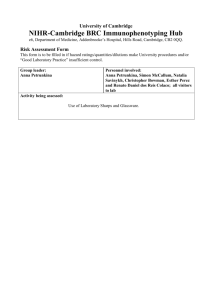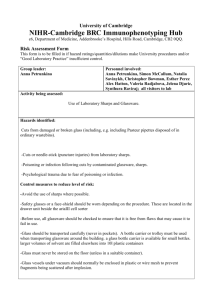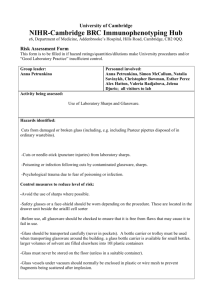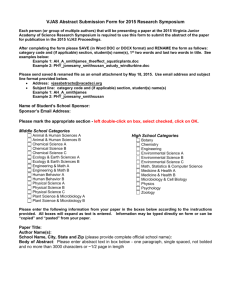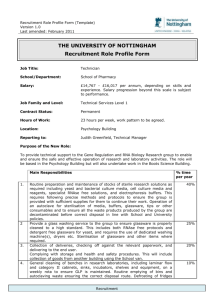General Microbiology Lab Rules
advertisement
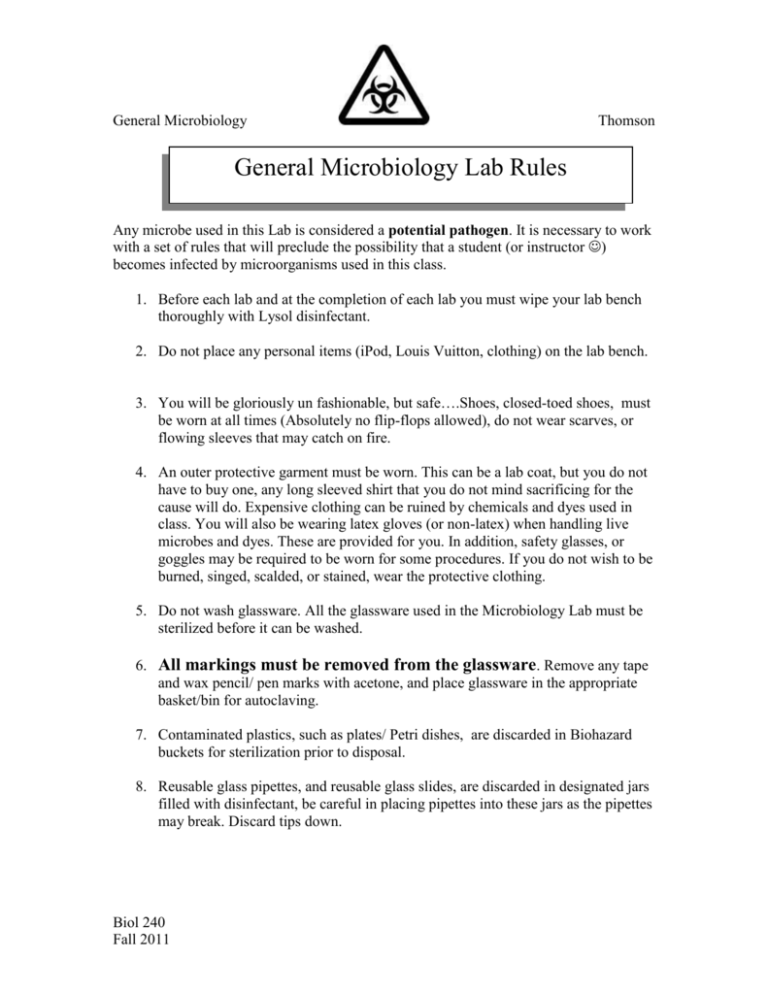
General Microbiology Thomson General Microbiology Lab Rules Any microbe used in this Lab is considered a potential pathogen. It is necessary to work with a set of rules that will preclude the possibility that a student (or instructor ) becomes infected by microorganisms used in this class. 1. Before each lab and at the completion of each lab you must wipe your lab bench thoroughly with Lysol disinfectant. 2. Do not place any personal items (iPod, Louis Vuitton, clothing) on the lab bench. 3. You will be gloriously un fashionable, but safe….Shoes, closed-toed shoes, must be worn at all times (Absolutely no flip-flops allowed), do not wear scarves, or flowing sleeves that may catch on fire. 4. An outer protective garment must be worn. This can be a lab coat, but you do not have to buy one, any long sleeved shirt that you do not mind sacrificing for the cause will do. Expensive clothing can be ruined by chemicals and dyes used in class. You will also be wearing latex gloves (or non-latex) when handling live microbes and dyes. These are provided for you. In addition, safety glasses, or goggles may be required to be worn for some procedures. If you do not wish to be burned, singed, scalded, or stained, wear the protective clothing. 5. Do not wash glassware. All the glassware used in the Microbiology Lab must be sterilized before it can be washed. 6. All markings must be removed from the glassware. Remove any tape and wax pencil/ pen marks with acetone, and place glassware in the appropriate basket/bin for autoclaving. 7. Contaminated plastics, such as plates/ Petri dishes, are discarded in Biohazard buckets for sterilization prior to disposal. 8. Reusable glass pipettes, and reusable glass slides, are discarded in designated jars filled with disinfectant, be careful in placing pipettes into these jars as the pipettes may break. Discard tips down. Biol 240 Fall 2011 General Microbiology Thomson 9. Sharps: - somebody will drop something. When this does happen glassware fragments (sharps) are disposed of in a special cardboard box. Broken glass never goes into the trash, or biohazard bins. . 10. Be familiar with how to safely clean up spills on your desk. Inform the instructor of any spills that contain living organisms, such as bacterial cultures. a. For spills on your desk, spray with Lysol, cover spill with paper towel, allow Lysol time to work. Dispose of bottom towel in biohazard bin. Other towels used to clean desk can go in trash. b. For broken glass culture tube- follow steps above, BUT sweep of fragments of glass which will be disposed of in Sharps container. 11. Be sure to clearly label all your glass and plastic ware; any unmarked items in the incubators will be discarded. Include your name, bench number, species (if known), location of sample (if species unknown), and date. 12. Remove labels from testtubes with acetone before placing them in wire baskets for autoclaving. Do not remove the caps. 13. Bunsen burners will be used frequently. Organize your desk so that you are not reaching over other equipment to use the Bunsen. Do not leave your Bunsen burner on if you are away from your desk. 14. There will be a. NO Smoking b. No eating or Drinking c. No pencils, fingers, hair etc. in the mouth, eye, nose etc. A word about aerosols… An aerosol is a tiny droplet of water, which in a microbiology lab, must be assumed to also contain living microbes. We produce aerosols as we breathe, and particularly when we cough or sneeze. In Lab there are many opportunities to inadvertently create aerosols; waving around a loaded loop or inoculating needle, swirling an open culture, spilling or dropping a culture etc. These droplets will eventually settle from the air onto the surfaces in class. This can lead to contamination of media in class and invalidation of experimental results. This is also the primary reason for the above lengthy list of rules. Because we share the lab with other sections, even if you and your partner are very diligent regarding the lab rules, other people in other sections may not be. Lab Notebook You must keep track of all your experiments in a Lab notebook. This serves several very important functions. It serves as your written memory. The lab manual contains instructions of how to set up an experiment. We will often make slight changes to the Biol 240 Fall 2011 General Microbiology Thomson procedures; different organisms, different incubation times, take samples from different locations ALL OF THESE DETAILS MUST BE RECORDED IN YOUR NOTEBOOK. It is also a useful place for you to make sketches and notes to yourself. You will make mistakes – once we figure out which type of mistake you make, technique, labeling, whatever, you can make a note of what you did wrong- and help to avoid this mistake the next time we do a similar procedure. Biol 240 Fall 2011
